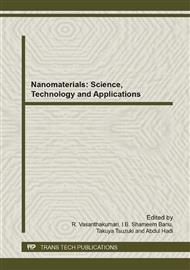p.114
p.118
p.123
p.128
p.134
p.140
p.145
p.151
p.158
Structural, Morphological, Optical, and Magnetic Properties of Fe-Doped CuO Nanostructures
Abstract:
Pure and Fe-doped CuO nanostructures with different weight ratios (0.5, 1.0, 1.5, and 2.0 at wt% of Fe) were prepared by a facile and fast microwave combustion method. The structure and morphology of the samples were investigated by X-ray diffraction (XRD), high resolution scanning electron microscopy (HR-SEM), diffuse reflectance spectroscopy (DRS), photoluminescence (PL) spectroscopy and vibrating sample magnetometry (VSM). The XRD patterns refined by the Rietveld method indicated the formation of single-phase monoclinic structure and also confirm that the Fe ions are successfully incorporated into the CuO crystal lattice by occupying Cu ionic sites. Interestingly, the morphology was found to change considerably from nanoflowers to nanorod and disk-shaped then to nanoparticles with the variation of Fe content. The optical band gap calculated using DRS was found to be 2.8 eV for pure CuO and increases up to 3.4 eV with increasing Fe content. Photoluminescence measurements also confirm these results. The magnetic measurements indicated that the obtained nanostructures are found to show a room temperature ferromagnetism (RTF) with an optimum value of saturation magnetization at 2.0 wt.% of Fe-doped CuO, i.e.1.2960 x 10 -3 emu/g.
Info:
Periodical:
Pages:
134-139
Citation:
Online since:
June 2014
Authors:
Price:
Сopyright:
© 2014 Trans Tech Publications Ltd. All Rights Reserved
Share:
Citation:


